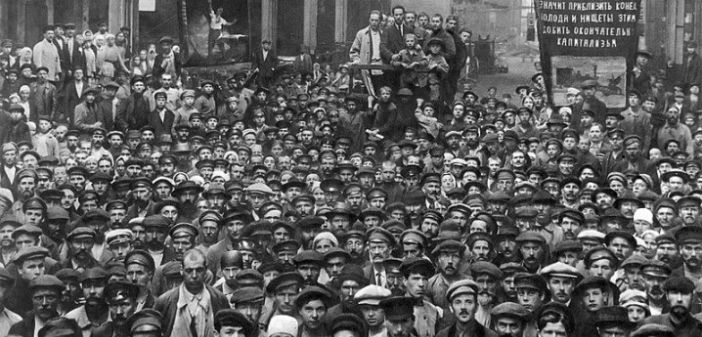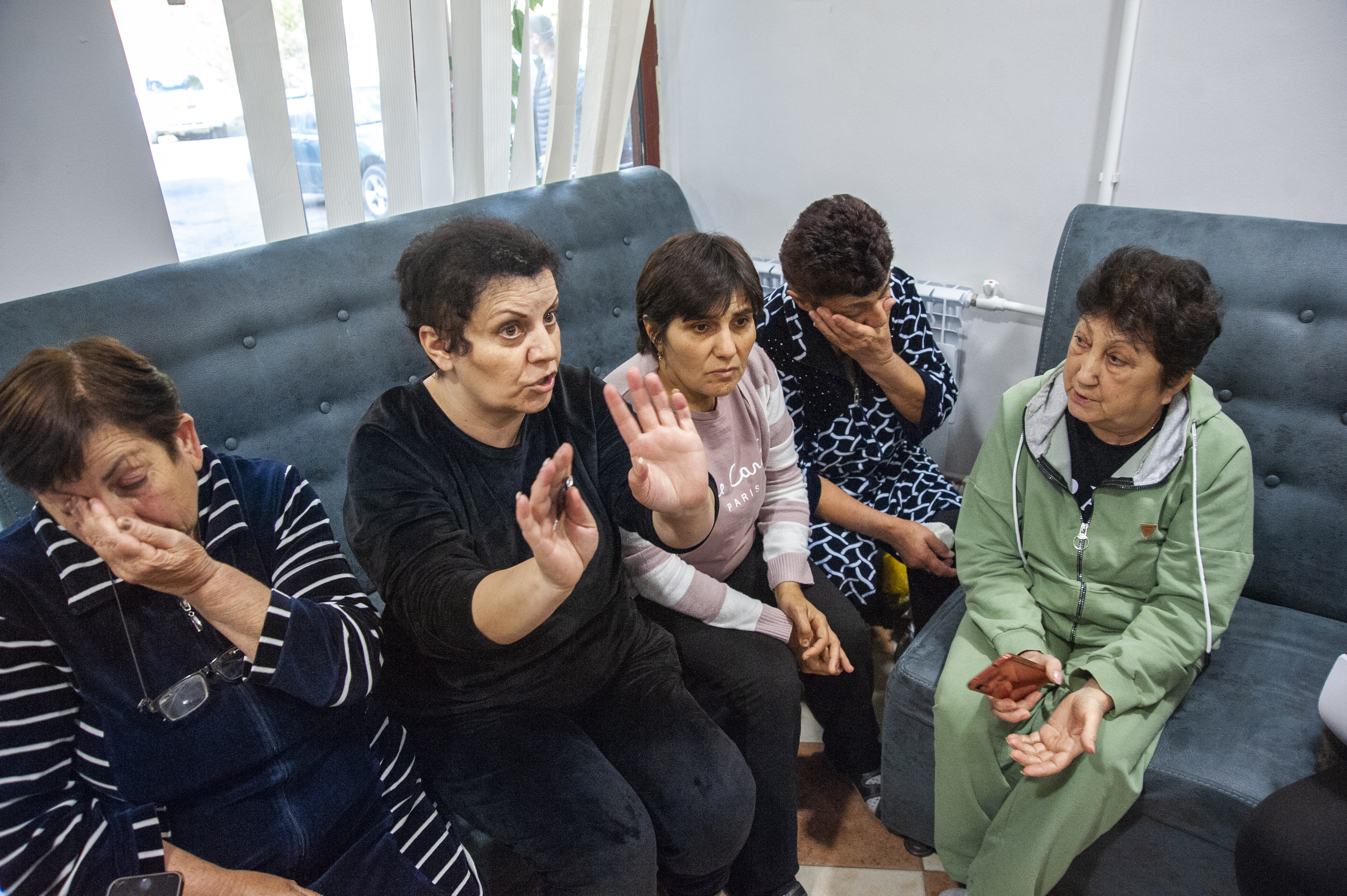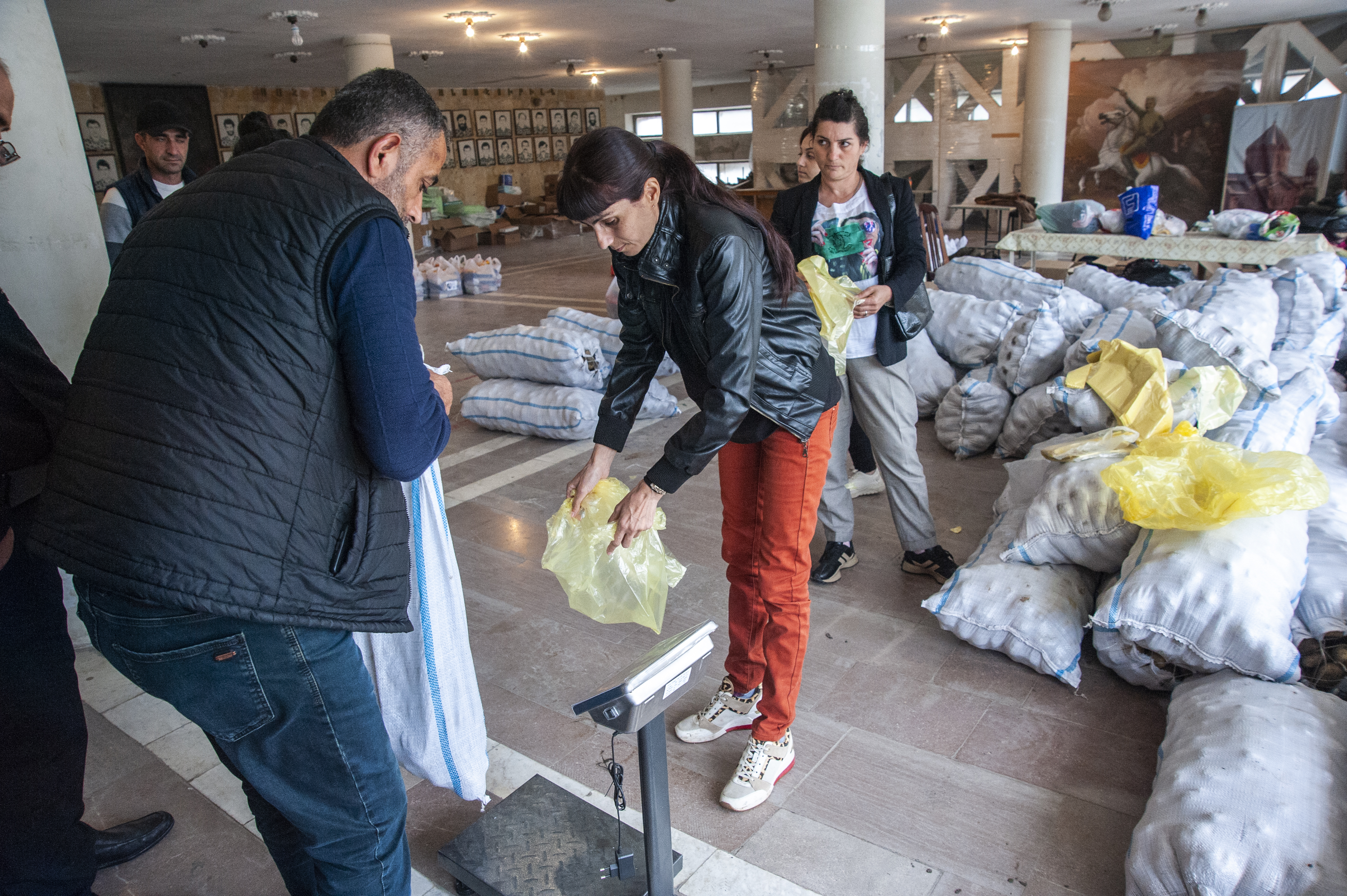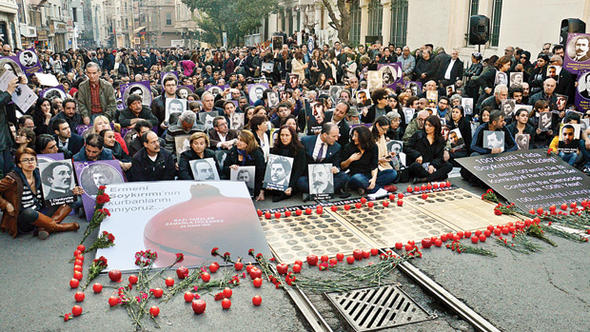A year ago I taught at the Higher School of Economics in St. Petersburg, Russia and spent a beautiful fall with eager students learning from an American Armenia about the history of their country… well, about the Soviet Union, a country which they had never experienced. From the window of my apartment in central St. Petersburg, overlooking Labor Square and facing the Nikolaevskii Palace (the Palace of Labor), I was impressed by the contrasts in what in 1917 was the capital of the Russian Empire. The imperial city lay on this side of the river. Across the Neva were the workers’ districts, Vasilli Island and the Vyborg Side, the latter a fortress of Bolshevik support. Out in the Finnish Gulf is the naval fortress of Kronstadt, where the sailors and machine gunners were among the most radical men with arms close to the palaces of power. In ten or fifteen minutes I could walk to Marinskii Palace or the Winter Palace, the headquarters during the revolutionary year of the liberal-conservative Provisional Government that the Bolsheviks overthrew in October. The built environment impressed by its historical weight. And yet on the streets, hurrying home from work, were people whose lives seemed far removed from the events of a hundred years ago.
This was the post-Soviet space. Instead of anything resembling any form of socialism, neo-liberal capitalism and authoritarian politics reigned. Talk to the taxi drivers and the university professors, or your landlord and his friends, and you realized that most people share deeply conservative rather than progressive habits of mind. A combination of relative isolation from much of the world mixed with curiosity about the material comforts and pleasures of the West. Their sensibilities left over from Soviet times, people exhibited a palpable anxiety about the future and the dangers presented by foreigners and foreign powers. At the same time Russians clinged to the expectation that government ought to protect and promote its citizens. Apparently, you can take Russia out of the Soviet Union, but you can’t take the Soviet Union out of Russia.
Nineteen-seventeen was the second great cataclysm of the short twentieth century, the first being the outbreak of the Great War that set off what many historians, Left and Right, have called the international civil war. The revolutionaries in Petrograd, as the city was renamed to rid it of anything sounding German, were initially motivated by hunger, cold, and resentment at the callousness and incompetence of the tsarist government. Women were the first into the streets, on International Women’s Day (February 23 by the Julian calendar, March 8th by the Gregorian), and they shamed the men in the factories to come out onto the streets. The inchoate rebellion became a revolution when the soldiers, including the imperial guards regiments, refused to fire on the crowds. The tsar abdicated; Duma politicians set up the Provisional Government; and the workers and soldiers elected their own representatives to the soviets. The first lesson of the revolution was that ordinary people with only the most perfunctory leadership could make history, topple a three-hundred-old year dynasty, and initiate radical social change with unpredictable consequences.
In the seven months that followed Russia experienced a festival of democratic experimentation. Every constituency in the city, and throughout the country, formed committees, held meetings, elected delegates to congresses, passed resolutions, and expressed directly their fears of counter-revolution and hopes for a more just, egalitarian, and participatory political system and social order. But civil war was in the air from the very first days with the city and country divided between the lower classes organized in soviets and increasingly becoming more radicalized and gravitating toward the Bolsheviks and the middle and upper classes rapidly losing faith in democracy and turning to strong men and the remnants of the army to reverse the gains of the workers, peasants, and soldiers. The second lesson of the revolution was that no shared consensus on the future united Russia’s polarized society. Lenin and the Bolsheviks understood the impossibility of coalition of the “vital forces of the nation” advocated by their former comrades, the Mensheviks, and called for “All Power to the Soviets,” that is, a government excluding the middle and upper classes, what was known as tsentsovoe obshchestvo, and limited to what in Russian was called the demokratiia, the people who worked with their hands or served with arms. Class conflict in major cities made the victory of the Bolsheviks possible, but Soviet Power was at the same time a declaration of civil war.
Progressively, with the Bolshevik overthrow of the relatively democratically elected Constituent Assembly in January 1918, the emasculation of worker and soviet institutions, and four years of fighting against White counter-revolutionaries, anarchist and peasant armies, foreign interventionists, separatist nationalists, and more moderate socialists, the democratic institutions and practices of 1917 atrophied. Terror replaced persuasion; military discipline and the prohibition of factions within the Communist Party eliminated the rough and tumble infighting of the Bolsheviks before 1921; bureaucracy burgeoned; and political decision-making narrowed to the Central Committee, then to Politburo, and ultimately to one man, Joseph Stalin. The harshest lesson of the revolution was that war and civil war polarize politics, undermine democratic choices, and give well-placed elites enormous discretion to shape the nature of the political regime. Without strong institutions to constraint the actions of those in positions of influence and power, however humane and progressive their ambitions and goals, the will of the people will be compromised, even jettisoned. This lesson would be made even more starkly with the final crisis of the Soviet Union, when democrats attempted to overthrow Communist rule only to weaken the entire polity. Self-proclaimed reformers around Boris Yeltsin then carried out their own coup d’état in 1993 and imposed a powerful presidency that eventuated in the authoritarianism of Vladimir Putin.
Journalists and even scholars have often facilely explained the failure of Russians to achieve more democratic and representational politics in 1917-1921 and 1989-1993 as the fault of ordinary Russian and Soviet people, a people, it is said, with a deep, authoritarian streak, who possess a political culture or even a genetic propensity to love slavery, disregard the value of human life, and yearn for strong men to rule them. Such fantasies of national character and embedded culture are much more revealing of their authors than of the actual experience and history of the largest country on the globe. Essentialist claims about Russia and its leader, Vladimir Putin, became a staple during and after the American presidential campaign in 2016. Generalizing about Russian character or history is a pernicious practice that leads more easily to distortion and confusion than to enlightenment.
Human beings, Karl Marx wrote, make their own history but not under circumstances chosen by themselves. History constrains as well as enables. Another lesson learned from looking at the Russian Revolution is that opportunities were missed, though they were fleeting; risks not taken; wrong choices made that sent the revolution down a tragic track. In October 1917 Lenin had boldly and purposefully convinced his closest comrades that it was time for the soviets to take power. He spurred them to action when many of his closest associates were hesitant. His strategic genius, his perceptive reading of the social dynamics of the moment, brought his party to power in a few days with minimal losses at the time. Four years later in March 1921, he faced another moment of decision. As the civil war wound down, the central party leaders experienced new threats: strikes in Petrograd and other cities; the mutiny of the Kronstadt sailors calling for soviets without Communists; massive peasant revolts; and within the party ranks opposition to the policies of War Communism, bourgeoisification of the party, and undemocratic and authoritarian practices. Lenin tacked toward moderation on the economic front and introduced the state capitalist program of NEP (New Economic Policy). But he made no compromise with the actively rebellious sailors, workers, or peasants and sanctioned a major campaign against the insurgent sailors of Kronstadt and the peasant rebels in Tambov province and elsewhere. And at the Tenth Party Congress, against the Workers’ Opposition led by Aleksandra Kollontai and Aleksandr Shliapnikov, he pushed through the plank forbidding organized factions within the party. Economic liberalization on the one hand, and political tightening on the other. NEP worked well; factories began to whirr again; peasants produced more now that they were allowed to keep part of their output after paying a tax in kind to the state. But in the political sphere party democracy rapidly withered. Oppositions fell one after the other, as Stalin steadily defeated his enemies and consolidated his power. By the twentieth anniversary of October a one-man dictatorship based on police terror and the strictest control of public media and education turned on the party ranks itself and murdered hundreds of thousands of Communists, including Lenin’s closest comrades. Millions of ordinary citizens were deported, exiled, imprisoned, or executed. Nearly 700,000 people were shot in 1937-1938 alone. As Trotsky, then himself in foreign exile, put it, a river of blood separated Lenin and Stalin.
A Russian historian at a prestigious West Coast university once told me with great conviction that nothing good came out of the Soviet Union. There was nothing redeemable or praiseworthy. Taken aback by so categorical a condemnation, I asked, what about the victory of over fascism? The Soviets, after all, took on three quarters of the Nazi forces, as well as allied Finns, Rumanians, Hungarians, and others. They liberated Auschwitz and other death camps in the east and essentially brought the Holocaust to an end. Ironically, it was the Red Army that saved the world for democracy and capitalism. What about industrialization of a vast peasant land, forced to be sure, inefficient, chaotic, and haphazard in many ways, but adequate enough eventually to raise the standard of living of tens of millions, turn the country from 80 percent rural to 80 percent urban, and create an educated population that after a half century of paternalistic rule no longer in any way required domination by the superannuated Communist Party?
A lesson of studying Russian and Soviet history ought to be that black-and-white images hide more than they reveal, that complexity and nuance, anomalies and contradictions must be recognized. Considering what the Soviets proudly called their dostizheniia (achievements) does not require whitewashing the horrors of collectivization, the Ukrainian famine (Holodomor), ignoring the wasted lives of Stalin’s Great Purges, or the thousands of petty absurdities that characterized everyday Soviet life.
The Russian Empire was one of the most backward states in Europe in 1917, considered the “prisonhouse of nations,” a colonial power that competed with the great European overseas empires for its place in the sun. The October Revolution turned Russia into the leading anti-imperialist, anti-colonial country in the world. While its practices would never quite live up to its grandiose promises, the Soviet Union was the defender of national liberation movements around the world at a time when the United States was sending its troops near and far to suppress anti-imperialisms that appeared to be favoring Communism. Within the Soviet state, which in its own way was a peculiar empire in which goods and services flowed from center to periphery rather than the other way round, hundreds of ethnic and national groups were given cultural, educational, and political institutions while their sovereignty was usurped by Moscow. Leninist programs made nations within the body of the empire, not perhaps under circumstances chosen by themselves, but promoting ethnonational development to the point that by 1991 Soviet nations were ready to jump ship and declare themselves independent of the Kremlin. Soviet nationality policies kept the peace between ethnicities for seven decades and even forged a transnational identification with the USSR as a whole. Kazakhs and Ukrainians, along with Russians and Azerbaijanis, fought against fascism in World War II for both their national homelands and the Soviet state. Whatever ethnic hostilities they held in the post-war period were embedded in discriminations favoring the titular nationalities of certain republics or sublimated in football rivalries.
After the death of Stalin, a similar reversal of economic exploitation with many of the states in East Central Europe occurred as well. “Goulash Communism” created higher standards of living in Hungary and Poland than in the USSR itself. Deviation from the Soviet Bloc, however, could result in the unwelcome suppression by the Soviet Army, as in 1953 (East Germany), 1956 (Hungary), and 1968 (Czechoslovakia). The Soviet Union was, like many empires, a developmentalist state. It changed itself and those nations and states subordinated to it without agreeing to grant them sovereign power until the Gorbachev years. Its mission civilisatrice was hampered by its own underdevelopment and overstretched ambitions, yet colonized peoples around the globe studied in Moscow and looked to the Soviets as a viable alternative to capitalism.
Trotsky wrote his famous essay “Lessons of October” in 1924 in the belief that too little was known about the October Revolution and that other countries needed their own October. We might also consider what October might teach us today about the future of socialism (and democracy, which is so intimately connected to socialism), but only by appreciating the ambiguous legacy of Soviet “socialism.” A central irony of the Soviet experiment is that what it did in the name of Marxism in many ways crippled Marxism itself. To Western liberals and conservatives, what Stalin built was socialism, and it looked pretty unattractive to those living in the developed West. Democratic socialists, neo-Marxists, and Social Democratic parties attempted to carve an independent space for non-Communist socialism with notable results in many cases, but to large publics Marxism was seen as a descent into dictatorship evidenced by the cases of one- party Leninist states.
The October Revolution occurred at a moment of acute crisis for the European political order. Capitalism, imperialism, national rivalries, combined with racist assumptions about other nations, had catapulted the continent into the bloodiest and most devastating war that the world had ever seen. Out of that conflict came the international civil war that pitted Communism, Liberalism, and Fascism against one another until first the anti-fascist forces defeated fascism and later Soviet-style Communism collapsed with the triumph of neo-liberal economics and bourgeois democracy. At the turn of the twenty-first century socialism in most of its historic forms appeared to be discarded on the trash heap of history, while racism, authoritarianism, xenophobia, and religious fundamentalism competed against an increasingly embattled liberalism. As in 1917, so a century later, we are living in a moment of global crisis, both economic and political, but now the greatest challenge for the Left is to find a way to move beyond the limits of bourgeois democracy toward a sustainable democratic socialism.
The picture looked bleak from my Petersburg window last fall as I thought about both Russian and American politics. The triumph of a clueless celebrity candidate for president; the reduction of political discourse to vicious politically incorrect, racist sound bites; the obsequiousness of the mass media in a political system in which money is speech, corporations are people, and justice and elections are decided by how much money one can raise (these are fundamental characteristics of bourgeois democracy) made me think that the Russian optimist might be right. When the pessimist complained that things cannot get any worse, the optimist declares, yes, they can.
In Russia people feel there is no viable alternative to Putin. Democracy has been discredited, since it created criminality, chaos, poverty, and oligarchs in the 1990s. Strength and fortitude in the face of American aggression (that’s how they see it!) are called for, even as people tighten their belts. A hundred years after October it is very hard to find a socialist in Russia, even though so many of ordinary people’s values are the fruit of an ostensibly “socialist” experience in the years of Soviet power. Most Russians retain both democratic and socialist impulses, even though they might not call them that. Self-styled democratic socialists are extremely rare, and those who proclaim themselves Communists more closely resemble fascists. Yet both polls and conversations with people indicate fundamentally humanistic sensibilities; a deep feeling of connectivity to community; appreciation of democratic rights of speech, assembly, travel, and religion; the conviction that government ought to provide social protections and welfare to its citizens; and a deep commitment to egalitarianism.
The basic take away from October and the Soviet experience is that there is no real socialism without democracy, while the fundamental take away from Russian and American politics today is that there is no democracy without socialism. That is, there cannot be polarized inequality; great sums of money or an overweening government distorting elections, the media, and education; lack of opportunity to advance; no secure basis on which to live and raise one’s family, and still have a truly democratic society and politics in which ordinary people can make meaningful decisions about their lives and leaders.
It is always easier to state the nature of a problem than to find a solution. Perhaps the tentative first step would be to think clearly about the history of the twentieth century, what missteps were made and what successes were achieved. Understanding the past and how the present was constructed may lay the ground for rethinking how to make a future worth living in. Dark times may lay ahead, but progressive discourses, like history, are powerful enablers and constraints. A new more positive, perhaps even utopian, discourse about democracy and socialism will provide a light at the end of a dark tunnel. Right now the task is to find that tunnel.
RONALD GRIGOR SUNY is the William H. Sewell Jr. Distinguished University Professor of History at the University of Michigan and the author of Red Flag Unfurled: History, Historians, and the Russian Revolution (London and New York: Verso Press, 2017).





